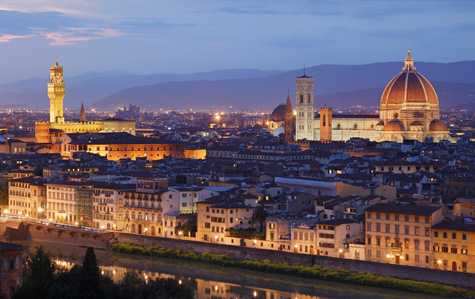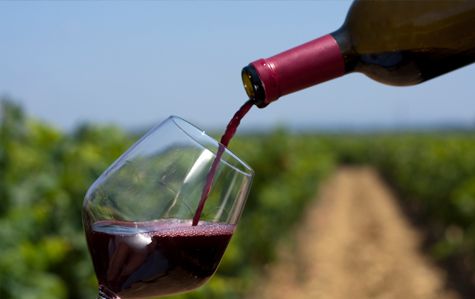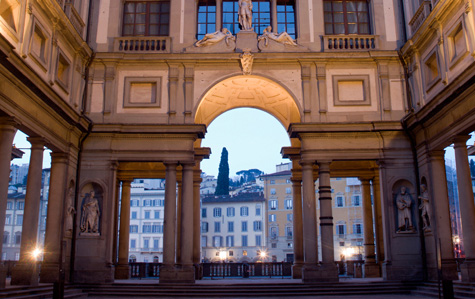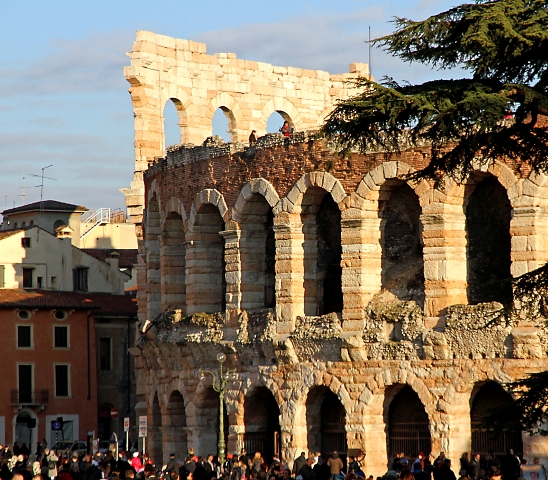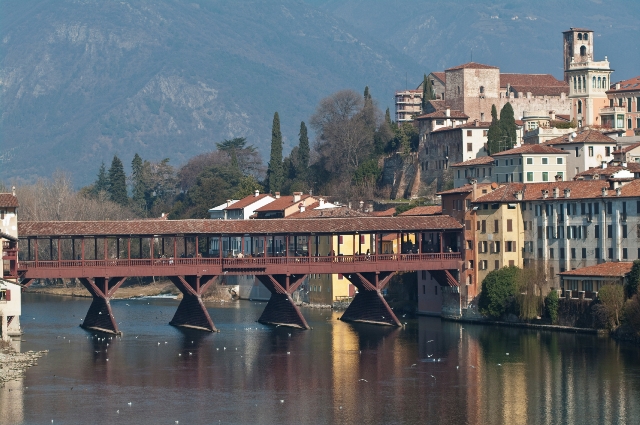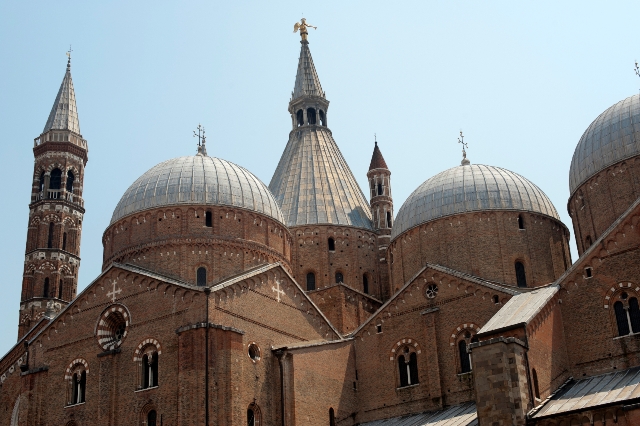Tour
Venice
A tour in Veneto begins of course with an excursion to Venice, dream aim of travelers from all countries. The city still enchants whole world with its elegant palaces, romantic water ways, fascinating squares and close alleys. The winged Lion of St Mark emblem of the city reminds of last times in which Venice was the richest city of the world. Today still stands the island city often presumed dead in the limelight of, only with other main points: the Venice Biennale, one of the most prestigious cultural institutions in the world, film festivals, exclusive world exhibitions, the well know carnival and other famous parties and festivals. From the lagoon by boat you reach Piazza San Marco, a unique experience and one of the most beautiful symbols in the world.
This magnificent square was called by Napoleon as the "most beautiful salon of Europe". Piazza San Marco was always a center of the Venetian life and is from the most famous sights of Venice surround: the bell tower, the splendid Palazzo, the Campanile with its 95 meters high, from which Galileo Galilei demonstrated his telescope to the Doge of Venice and the wonderful St Mark Basilica. For its opulent design, gold ground mosaics, and its status as a symbol of Venetian wealth and power, from the 11th century on the building has been known by the nickname Chiesa d'Oro (Church of gold). Just near it there is the Doge`s Palace and the Sighs Bridge. After a short walk through the close alleys you enjoy from the Rialto Bridge a fantastic view on the Grand Canal.The Rialto Bridge, which spans one of the narrowest points of the Grand Canal, carries a thoroughfare divided into three lanes by two arcades housing shops. The original structure was Venice’s very first bridge; built in 1180 to connect the banks of the Grand Canal it was a pontoon bridge known as Ponte della Moneta. In 1264 it was replaced by a wooden bridge with central drawbridge section that could be raised to let ships pass. In 1444 it collapsed under the weight of a crowd watching a Regata. It was not until the end of the 16th century that it was rebuilt as a single-arched stone bridge designed by Antonio Da Ponte. Today the Rialto Bridge is one of four bridges crossing the Grand Canal.
Bassano del Grappa and Marostica
Today is dedicated to visit the small and less known places of Veneto. You begin with a walk through the idyllic small town Bassano Del Grappa. it takes its name from the nearby high mountain Monte Grappa. The four things for which Bassano del Grappa is best known are its covered bridge Ponte degli Alpini over the Brenta, sketched by Palladio, the strong grappa liqueur produced in the area, the military history of Monte Grappa and locally-produced ceramics.
Afterwards you visit the small town Marostica whose medieval centre comes from the 14th century. High about the city is enthroned the old castle in which lived around 1500 the lord of the castle Taddeo Parisio. It happened that two nobleman, Rinaldo D'Angarano and Vieri da Vallonara, fell in love with the beautiful Lionora, daughter of Taddeo Parisio, the Lord of Marostica's castle. As was the custom in that time, they challenged each other to a duel to win the hand of Lionora. Marostica finds its moment of greatest expression and renown in the world famous Chess Game. Every 2 years in September, the human chess game is played on the square of Marostica.
The crowning conclusion of this exciting day is the visit of a Grappa distillery. In the region of Veneto it is a tradition since about 1000-year. Even if a relationship between the word Grappa and the mountain of the same name cannot be established with certainty, these lands have had an old and fundamental role in the production of our distillate. Grappa is a unique distillate in the world, in being obtained from the distillation of a solid raw material: the vinaccia (marc), i.e. the skins of grapes remaining after the grapes are pressed to make wine.
Padua and Chioggia
Today you visit the interesting city Padua. Since the saint Antonius native in Lisbon has lived in Padua, the city is considered as "Holy". One of the highlight is the visit of the basilica St Antonius, shortly "Santo" named. The church is considered from the 13th century with its eastern appearance as the most famous pilgrimage church of Italy. Since centuries come pilgrims from the whole world to owe the saint or ask for force. Besides, is world-famous the Scrovegni Chapel with the frescoes implemented by Giotto which belong to the epochal works of the european art history.
The lively city is not only the city of the St Antonius, but also since long time by already 1222 created universities. Piazza Cavour is the center of the city where Caffé Pedrocchi is situated, one of the biggest café of Europe which became a very popular venue where local students, artists and politicians readily convened.
In the afternoon you go to Chioggia, also named little Venice. The small harbor lies on the most south corner of the Venetian lagoon and in its alleys and channels rules a quiet idyll. Here Goldoni found inspiration for many of his operas. Take a relaxing walk through the oldest part of the town and let yourselves taste the Italian ice, while you follow the animation in the Harbor.
Vicenza
Early in the afternoon you visit the small town Vicenza which was protected in 1994 by the UNESCO as part of the world cultural heritage. Vicenza is the soul of the international and important gold-smith's art and the masterpieces of the famous architect Andrea Palladio. The buildings characteristics of the townscape from the renaissance go back to him. So he created in the 16th century, for example, the municipal palace "Basilica Palladiana" and with the building of the "Teatro Olimpico” his last work, he ranks amongst his highest masterworks. When he sketched this impressive theater building according to antique models, he created at the same time the first thought of a theater house in the world.
Before you leave the city, you go up to the Basilica di Monte Berico, a well know pilgrimage church, from where you enjoy a wonderful look over the city and its surrounding countryside.
Verona
The beautiful city at the foot of Monte Lessini on the River Adige is world-famous by Shakespeare "Romeo and Julia" as well as because of its enormous Roman Amphitheater. From the castle San Leonardo you walk through romantic alleys to the Palazzo of the Capuletti from the 13th century with the balcony of the famous courting couple. On the way to the arena you admire some beautiful corners of the medieval oldest part of the town and the heart of Verona, the Piazza delle Erbe (with its picturesque vegetable market) and the Piazza dei Signori, with their historic buildings, including Loggia del Consiglio. The Piazza Bra has a number of classicist buildings. You reach the Arena, the Roman Amphitheatre in the square “Piazza Bra”. It is one of the best preserved and biggest amphitheatres of the Roman world. It has elliptical shape and its remains today include part of the external ring and of the caves. Today it hosts events of various types because of the outstanding acoustics and every summer music lovers flow out from the whole world. On the return trip towards Abano you visit one of the numerous vineyards in the Monti Berici, the hill landscape in the south of Vicenza. This wonderful day will finish with a pleasant wine tasting.
Lake Garda
The beautiful Lake Garda is certainly one of the favorite holiday destinations in Italy, surrounded from high cliff faces in the north and in the south with a wide sea washbasin with Mediterranean vegetation on the banks. You go first to Bardolino protected by the massif of the Monte Baldo against cold north winds; it rules here a mild climate all year round which makes possible among other things the cultivation of olive-trees. The olive oil of Lake Garda is estimated in Italy near Tuscany and Apulia also. You visit an olive oil museum and get interesting information of the production of the oil.
Further visit of Garda. This place gave its name to the lake and it is choose as a resort for its health climatic because of its position in the long, sheltered bay.
After a walk on the promenade you take early in the afternoon the ship to go along the east bank, past Bardolino, Lazise and Peschiera to Sirmione. It’s a picturesquely and beautiful place, which lies on a tongue of land, kilometer-wide in the lake. Wander by the narrow alleys and drink an Italian cappuccino in the lakeshore.
Boat excursion on the Brenta channel
Hugging the coast of the Brenta River channel that links Padua to Venice reveals a series of extraordinary Venetian Villas and delightful towns. This was the ideal extension of Venice onto the mainland, almost a continuation of the lagoon city: between the 16th and the 18th century the Brenta Riviera experienced a golden age which turned it into a privileged holiday resort for rich Venetian nobles. They built dozen of villas along its riverbanks, designed and decorated by masters of Italian art, visited by artists, popes, kings and men of culture, envied for their beauty, inhabited as country seats where they celebrated ritual floating processions, sumptuous dinners and festivities lasting until dawn.
Along the River one can admire more than fifty villas, once summer residences of the Venetian nobility. Quite interesting are the villages and the ancient bridges along the river.
Rich as a jewel casket, the villa Pisani is of outstanding interest to visitors, with frescoes by Tiepolo and Guarana, spectacular stables and the celebrated maze, epitomizing eighteenth century Venetian society which, in the game of the history, performed vanishing acts, only to appear once again. Preferred by Casanova, Galileo Galilei, Byron and D’Annunzio, painted by Tiepolo and Canaletto, described by Goethe and Goldoni, Villa Pisani hosted the French and the Russian Royal Families. Napoleon, the Hapsburg, the Savoy stayed here.
The lunch takes place aboard during the further trip in direction of Venice, while you admire magnificent Villas like the villa Barchessa Valmarana, the villa Gradenigo and the villa Foscari, named also “La Malcontenta".
Treviso and the Prosecco street
Treviso - is the city of the channels. Along the old Venetian city walls flows the river Sile. Its numerous watercourses and channels flow through the whole city center and give a picturesque atmosphere to the city. Along the river promenade rise houses, which directly were built over the water with facades painted with fresco, weeping willows which hold out their arms towards the water and royal palaces. The city which shows no outstanding buildings has her quite special attraction in the teamwork with water, nature and medieval construction. The main shopping street, Via Calmaggiore, follows the route of the old Roman road. Ends on Piazza dei Sígnori, which is the main square.
Here the Trevisan people meets for a glass of wine or for the well kwon "Splashing" drinks or takes just a seat in one of the numerous cafes.
On the small Piazza della Peschiera takes daily place the fish market. In the northern part of the city walls it is possibly to admire the Domenican Church S.Nicolò and the Franciscan's church.
You finish the visit with the landscape of the Prosecco Hills with its cultivation area DOC. In 1966 was initiated the street of the Prosecco and it is one of the first Wine Streets of Italy. Today, however, Prosecco-Street is still more extensive and more various. It became the street of the prosecco and the wines of the Conegliano Valdobbiadene Hill (Strada del prosecco e Vini Colli Conegliano Valdobbiadene).
The route leads the visitor not only by the prosecco DOC area, but also for discoveries like the rare wines of Cartizze, the Torchiato di Fregona and Refrontolo Passito. Along the route reveal themselves in every town Architecture treasures like aristocratic villas, antique monuments, churches and mills. It is a unique scenario: a network mixed in different colours of the vineyards which covers alternately the gentle hills and the steepest slopes. Here you can still feels the taste of tradition and the joy in the hospitality. A Prosecco tasting cannot be lacking.


